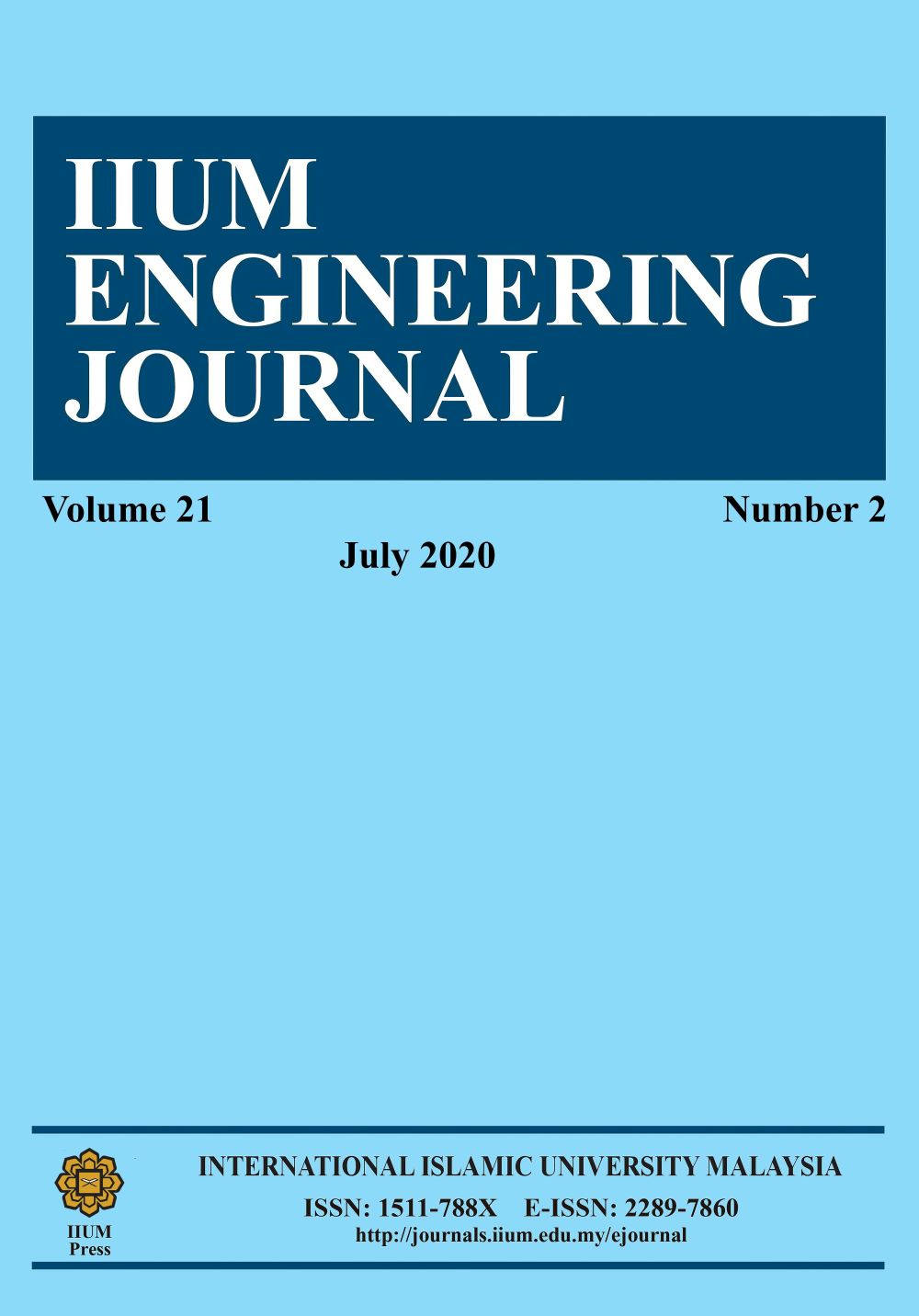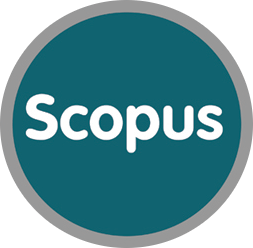ANALYSIS AND CORRELATIONS OF DIMENSIONLESS NUMBERS RELEVANT TO ORIFICES’ CAVITATING FLOW
DOI:
https://doi.org/10.31436/iiumej.v21i2.1306Keywords:
Hydrodynamic cavitation, Orifice geometryAbstract
The aim of this work was to establish a general design basis for pilot-scale units to treat textile dyeing wastewater containing recalcitrant organic chemicals by hydrodynamic cavitation (HC) using orifices of various geometries. Relevant tabulated data available in the literature were analyzed and correlated to obtain universal relationships to this end. In spite of extensive effort, most of the obtained correlations were system-specific, which still can be used for design using their respective orifice geometries as demonstrated. However, one salient general relationship links the pipe’s dimensionless loss coefficient (KLP) to the pipe’s Reynolds number (ReP), encompassing all data under consideration, which may serve as an additional design option to optimize such units. The implication of this relationship is a lower upstream pressure (P1) value with an increase in pipe diameter while using the same specified orifice and achieving the same desired cavitation number (Cv). The ratio of P1 value in the larger pipe to its value in the smaller pipe is a function of the smaller pipe diameter (DS) to the larger pipe diameter (DL) ratio: (P1 in DL) / (P1 in DS) = (DS /DL)2.33. A lower P1 value will increase the cavitation yield by decreasing the expended energy, especially if the required number of passes is large. Additionally, the variation of the orifices’ hole loss coefficient (KLh) with the ratio of the holes area to the pipe cross-sectional area (Ah/Ap) for cavitating flow is compared with that for non-cavitating/incipient cavitation flow reported in the literature.
ABSTRAK: Tujuan kajian ini diadakan bagi mereka bentuk dasar umum unit skala-pandu bagi merawat pewarnaan air buangan tekstil yang mengandungi kimia organik rekalsitran daripada peronggaan hidrodinamik (HC) menggunakan orifis pelbagai geometri. Data berjadual berkaitan yang ada dalam kajian lepas dianalisa dan dikaitkan bagi mendapatkan kaitan universal hingga akhir. Walaupun pelbagai usaha telah dijalankan, banyak kaitan didapati mengguna pakai sistem-tertentu, di mana boleh digunakan bagi mereka cipta menggunakan geometri orifis yang ditunjukkan. Walau bagaimanapun, bagi menghubung kait pekali langsung tanpa dimensi (KLP) kepada paip nombor Reynolds (ReP), meliputi semua data di bawah pertimbangan, di mana membantu pilihan rekaan tambahan bagi mengoptimum unit tersebut. Implikasi hubungan ini adalah nilai tekanan hulu sungai bawah (P1) dengan penambahan diameter paip dengan menggunakan orifis sama yang sebenar dan mendapati nombor peronggaan yang sama diingini (Cv). Nisbah nilai P1 dalam paip besar kepada nilai paip kecil adalah berkadaran pada nisbah diameter paip kecil (DS) kepada diameter paip besar (DL):
(P1 dalam DL) / (P1 in DS) = (DS /DL)2.33.
Downloads
Metrics
References
Braeutigam P, Franke M, Schneider RJ, Lehmann A, Stolle A, Ondruschka B. (2012) Degradation of carbamazepine in environmentally relevant concentrations in water by hydrodynamic-acoustic cavitation (HAC). Water Res., 46:2469-2477.
Patil PN, Bote SD, Gogate PR. (2014) Degradation of imidacloprid using combined advanced oxidation processes based on hydrodynamic cavitation. Ultrason. Sonochem., 21:1770-1777.
Pradham AA, Gogate PR. (2010) Removal of p-nitrophenol using hydrodynamic cavitation and Fenton chemistry at pilot scale operation, Chem. Eng. J., 156:77-82.
Sivakumar M, Pandit AB. (2002) Wastewater treatment: a novel energy efficient hydrodynamic cavitational technique. Ultrason. Sonochem., 9:123-131.
Saharan VK, Pandit AB, Kumar PSS, Anandan S. (2012) Hydrodynamic Cavitation as an Advanced Oxidation Technique for the Degradation of Acid Red 88 Dye. Ind. Eng. Chem. Res., 51:1981-1989.
Madhu GM, Thomas A, Deepak S, Preetham HS, Rajanandam KS. (2015) Escalation of degradation of malachite green and methyl violet using hydrodynamic cavitation using different orifice geometry. Int. J. Env. Sci., 5(4):880.
Mancuso G, Langone M, Laezza M, Andreottola G. (2016) Decolourization of Rhodamine B: A swirling jet-induced cavitation combined with NaOCl. Ulatrason. Sonochem., 32:18-30.
Rajoriya S, Bargole S, Saharan VK. (2017) Degradation of reactive blue 13 using hydrodynamic cavitation: Effect of geometrical parameters and different oxidizing additives. Ultrason. Sonochem., 37:192-202, DOI:http://doi.org/10.1016/j.ultsonch.2017.01.005
Pawar SK, Mahulkar AV, Pandit AB, Roy K, Moholkar VS. (2017) Sonochemical Effect Induced by Hydrodynamic Cavitation: Comparison of Venturi/Orifice Flow Geometries. AIChE Journal, 63(10):4705-4716.
Testud P, Moussou P, Hirschberg A, Auregan Y. (2007) Noise generated by cavitating single-hole and multi-hole orifices in a water pipe. J. Fluids and Structures, 23:163-189.
Vichare N P, Gogate PR, Pandit AB. (2013) Optimization of hydrodynamic cavitation using a model reaction. Chemical Engineering Technology, 23:683-690.
Maynes D, Holt GJ, Blotter J. (2013) Cavitation Inception and Head loss Due to Liquid Flow Through Perforated Plates of Varying Thickness. J. Fluids Eng., 135: 031302-1—031302-11.
Yan Y, Thorpe RB. (1990) Flow Regime Transitions Due to Cavitation in the Flow Through an Orifice. Int. J. Multiphase Flow, 16 (6):1023-1045.
Gogate PR, Pandit AB. (2000) Engineering Design Methods for Cavitation Reactors II: Hydrodynamic Cavitation. AIChE J., 46 (8):1641-1649.
Gogate PR, Shirganokar IZ, Sivakumar M, Senthilkumar P, Vichare NP, Pandit AB. (2001) Cavitation Reactors: Efficiency Assessment Using a Model Reaction. AIChE J., 47 (11):2526-2538.
Gogate PR, Pandit AB. (2005) A review and assessment on hydrodynamic cavitation as a technology for the future. Ultrason. Sonochem., 12:21-27.
Carpenter J, Badve M, Rajoriya S, George S, Saharan VK, Pandit AB. (2017) Hydrodynamic cavitation: An emerging technology for the intensification of various chemical and physical processes in a chemical process industry. Reviews in Chemical Engineering, 33(5):433-468. https://doi.org/10.1515/revce-2016-0032.
Burzio E, Bersani F, Caridi GCA, Vesipa R, Ridolfi L, Manes C. (2020) Water disinfection by orifice-induced hydrodynamic cavitation. Ultrasonics-Sonochemistry, 60, 104740: 1-13.
Rajoriya S, Carpenter J, Saharan VK, Pandit AB. (2016) Hydrodynamic cavitation: an advanced oxidation process for the degradation of bio-refractory pollutants. Rev. Chem. Eng., 32: 379-411.
Downloads
Published
How to Cite
Issue
Section
License
Copyright (c) 2020 IIUM Press

This work is licensed under a Creative Commons Attribution 4.0 International License.






















